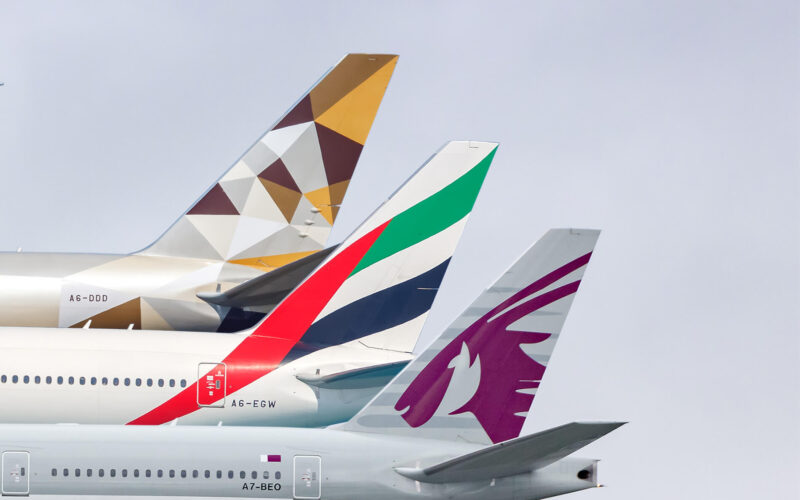Despite rising numbers of the COVID-19, the aviation industry seems to be on the recovery track. Three largest Middle Eastern airlines – Emirates, Etihad Airways and Qatar Airways – are continuing to expand their networks. But which one of them is the most active at that?
The premise was simple: as the worldwide lockdown commenced in March 2020, most airlines stopped operating completely; Qatar Airways did not and continued half-passenger half-cargo flights to more than two dozens of destinations.
Hence, as international travel began growing in April and May, Qatar had a firm lead in the number of destinations. But Emirates and Etihad started growing their networks immediately and, by June, came very close to challenging Qatar.
Etihad – having a myriad of problems, smaller pre-pandemic network notwithstanding – was not able to keep up, as sporadic expansions were not enough to be on the same level as the other two.
In August, it became clear that if Emirates keeps up their pace, Qatar – which briefly fancied itself as the world’s biggest airline – will be dethroned.
Incremental growth
While both of them still are expanding their networks incrementally, the pace has slowed. Etihad’s last large expansion happened in September, and since then only a couple of destinations have been added to the list.
Qatar kept expanding as well. Having proudly announced adding several completely new destinations on its list, it had 103 in mid-November 2020.
Emirates was the fastest-growing, though. Their network almost reached 100 destinations – two thirds of pre-pandemic 159 – in early November 2020. No updates were announced since then, freezing the airline at the same level.
Further expansions, delineated in this chart, are preliminary. Qatar announced plans in advance, stating that it intends to have 124 destinations in its network by the year’s end – meaning that 17 more destinations are still awaiting to be announced.
Emirates has a habit of restarting a whole bunch of scheduled flights at once. Seeing how close is the size of both airlines as of late November, Qatar’s lead does not look set in stone.
Etihad has announced one future expansion – flights to Tel Aviv (TLV) starting from February 2021 (not reflected in this chart). The first Middle Eastern airline to do so, it was able to secure a very profitable route, despite its difficult financial position.
What does it all mean?
The expansion of post-pandemic networks became a thing of honor for three largest Middle Eastern airlines, locked in a bitter rivalry. All of them were relatively spared by early lockdowns and managed to avoid large financial troubles, mostly thanks to backing of their respective governments.
Yet, as the pandemic drains revenue, they may have to let honor go. Operating unprofitable routes just for the sake of it is not a good strategy, even when there is no crisis going on.
There is also a question of reliability of this data. As discussed previously, it is difficult to confirm if scheduled flights are carrying any passengers, and sometimes – if they are happening at all. Both Qatar and to lesser extent Emirates had a habit of announcing an expansion to one or another destination several times in a row, conducting flights, stopping them for some reason, and renewing a month or two later with new pomp, as if it was the first time.
Because of this circumstance, the numbers represented above should be seen as a kind of approximation. Yet, despite that, it is clear that Emirates and Qatar are bent on besting each other in terms of their networks.
What can happen now? According to Qatar’s financial results, its financial year – which ended in March 2020 – was the worst yet, forcing the government to inject $2 billion into the airline. As much of the trouble happened even before the start of the pandemic, Qatar’s losses for the current financial year are bound to be monumental. We may not know that before September 2021, but if the airline suddenly starts dropping destinations left and right, it is going to be a sign of something bad.
Emirates, on the other hand, posted profit in March 2020. It was the smallest one in years, but still better than nothing. Yet, after posting the first-ever loss in their H1 results announced in early November 2020, they got $2 billion in government backing too.
On the one hand, expanding the network means opening new streams of badly needed revenue. On the other hand, it is imperative to select new destinations carefully, avoiding ones that may not be worth it in the long run. Looking at the numbers, it seems that both Qatar and Emirates are willing to risk.

